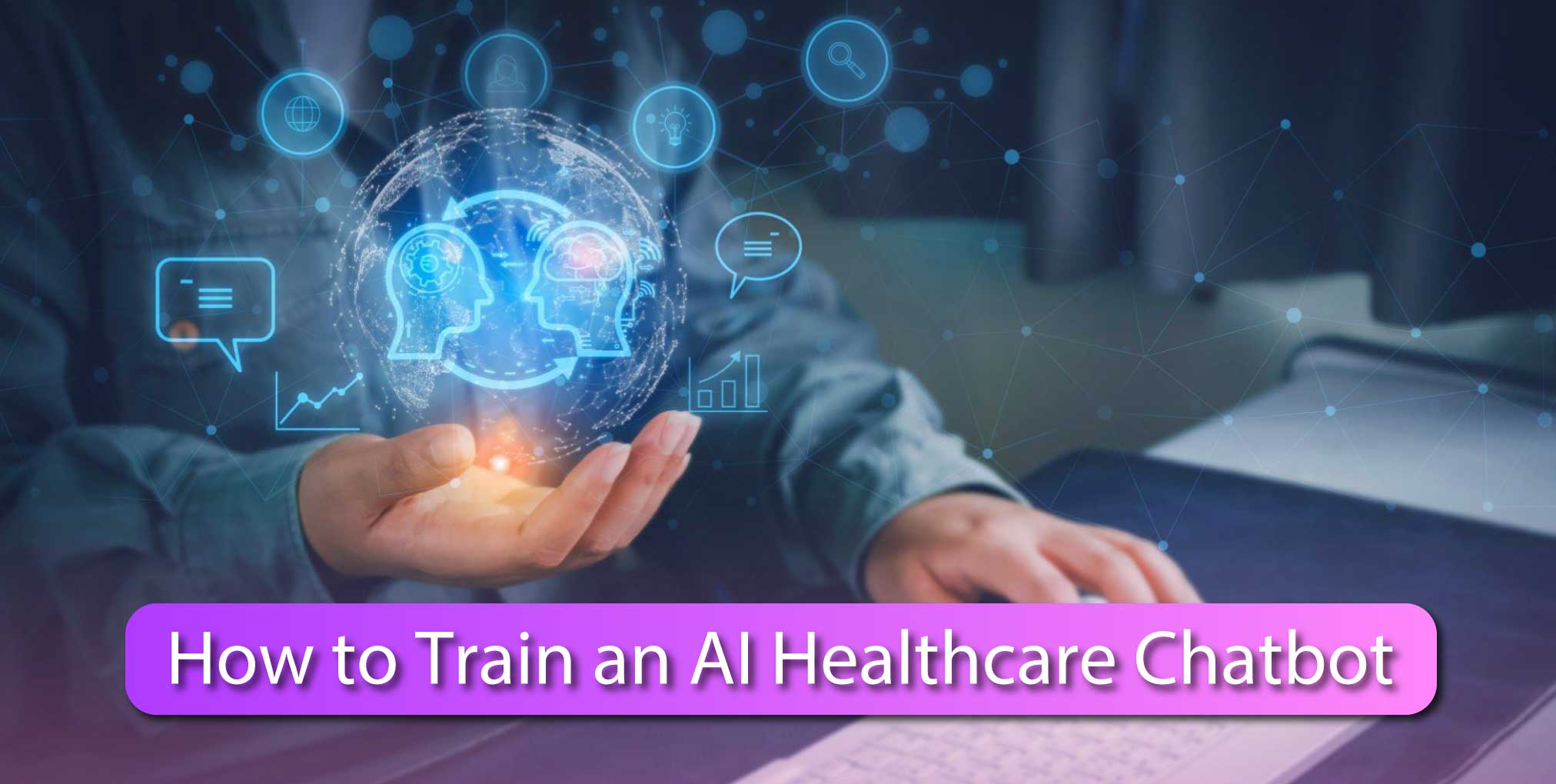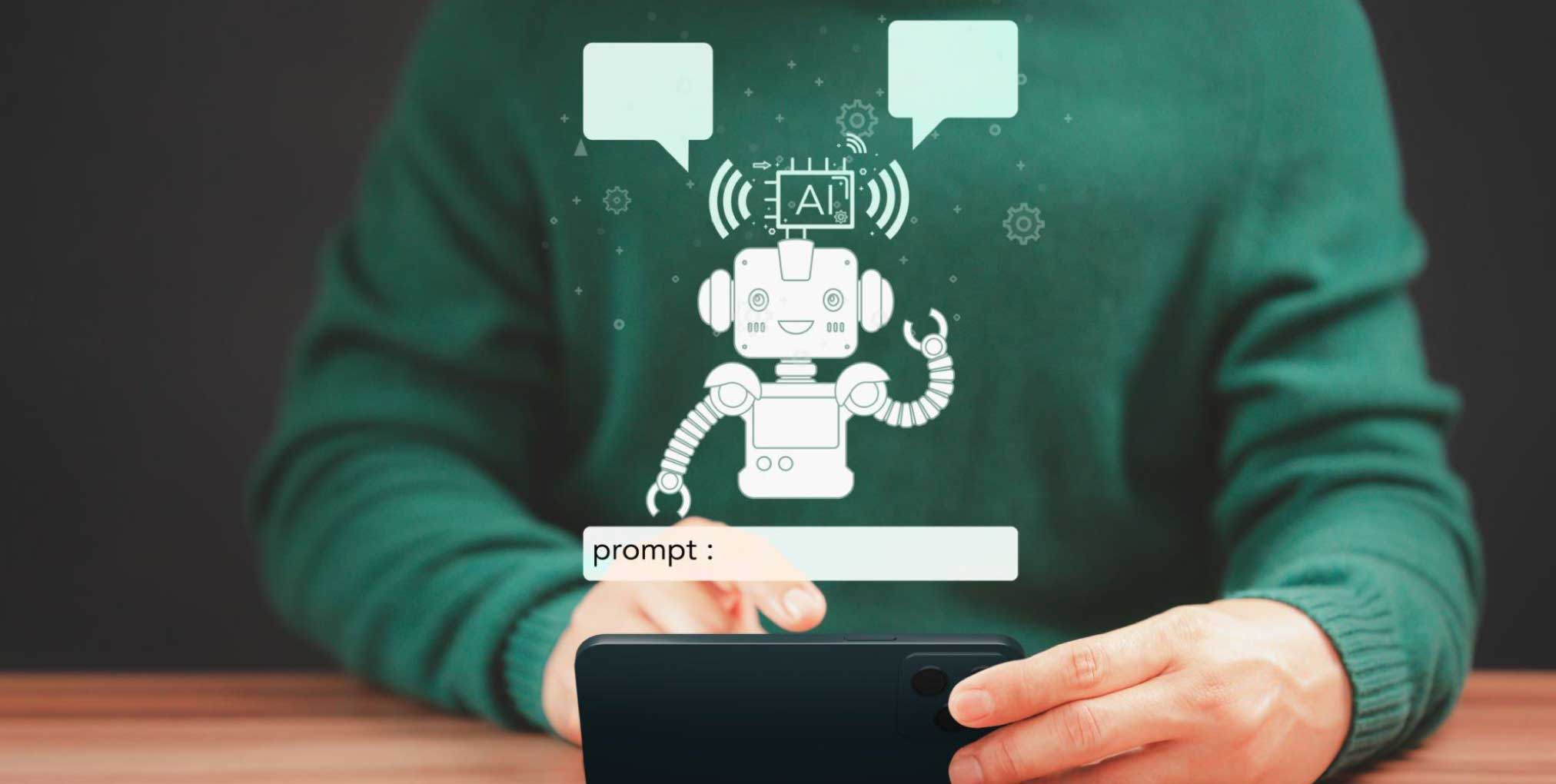

November 3, 2023
How to Train an AI Healthcare Chatbot: Top 10 Effective Tips
In an age where technology and healthcare intersect with unparalleled potential, AI-powered chatbots have transformed how we get medical help. These digital assistants are more than just a convenience; they have the power to enhance patient experiences, answer medical queries, and assist in appointment scheduling. However, their effectiveness hinges on the quality of training and development they receive.
Welcome to our comprehensive guide on How to Train AI Healthcare Chatbot. We will explore the steps to create a chatbot that offers trustworthy, precise, and compassionate healthcare support.
Importance of Training an AI Healthcare Chatbot
Now that we know what an AI Healthcare Chatbot is let’s explore why they’re so essential.
These smart chatbots play a vital role in the world of healthcare.
- When you’re feeling unwell or have questions about your health, they’re there to provide quick, reliable information and assistance.
- When you can’t reach a doctor or nurse immediately, ensure you get the guidance you need promptly.
- Their ability to save lives and time.
Imagine someone having a health concern late at night or in a remote area where immediate access to medical professionals is limited. An AI Healthcare Chatbot can step in, offering initial guidance. It’s like a knowledgeable friend who can help you decide if you should seek urgent medical attention or not.

10 Tips on How to Train AI Healthcare Chatbot
Training an AI healthcare chatbot requires careful planning, data collection, and model development. AI development services can be invaluable in this process. They provide the expertise and resources required for building a robust AI healthcare chatbot that meets the highest standards of accuracy and compliance with healthcare regulations.
Here are ten tips to help you create an effective AI healthcare chatbot:
1: Define Clear Objectives
-
Setting Specific Goals for the Chatbot
To train an AI Healthcare Chatbot effectively, it’s crucial to start by setting specific goals. Think of these goals as the chatbot’s job description. For example, your chatbot can assist users in scheduling doctor’s appointments, providing information on common health issues, or helping users find nearby pharmacies. These clear objectives guide the chatbot’s training and behavior.
Setting specific goals is like telling your chatbot, “Your main job is to help people schedule doctor’s appointments.” When the chatbot knows its role, it can focus on that task and provide more accurate and helpful responses. This ensures that the chatbot only tries to do a few things at a time, making it more efficient and user-friendly.
-
Identifying the Problem It Aims to Solve
Your AI Healthcare Chatbot should be designed to address a specific problem or need. For example, the problem could be the difficulty people need help finding a suitable healthcare provider in their area. By identifying this problem, the chatbot can be trained to collect and analyze information about local doctors, helping users make informed decisions.
-
Measuring Success Criteria
Once your chatbot has its goals and problem-solving mission, it’s essential to measure its performance. This is where success criteria come into play.
Success criteria are like report cards for the chatbot, telling you how it’s doing on the job. These criteria can include the number of correct answers it provides, the time it takes to respond, or user satisfaction ratings. Measuring success criteria helps you assess the chatbot’s effectiveness and identify improvement areas.
Read More: Benefits of Chatbots in Healthcare: The Future of Patient Care
2: Collect High-Quality Data
-
Sources of Healthcare Data
To train an AI Healthcare Chatbot effectively, you need to gather high-quality data. Think of data as the information the chatbot uses to understand and answer questions. This data can come from various sources, Such as:
- Medical Records: Medical records are like a detailed diary of your health. They hold information about your past health problems, such as what you’ve been diagnosed with, the treatments you’ve received, and the results of medical tests. The chatbot relies on these records to understand your health history.
- Medical Journals and Research: These sources are an ever-updating library of the latest medical knowledge and discoveries. Think of them as a source of the most recent health news. The chatbot needs access to this information to stay informed about the fast-changing world of healthcare.
- Websites and Health Portals: These are user-friendly websites and online health hubs. They provide general health information, helping the chatbot offer advice and answers to common health questions.
-
Data Quality and Privacy Considerations
When collecting data for your chatbot, it’s vital to ensure it’s accurate and safe. Data quality is like making sure the puzzle pieces fit together without any missing or broken parts. If the data is accurate, the chatbot may provide correct information, harming users.
Moreover, data privacy is essential to protect sensitive information. It’s like securing confidential data and preventing it from falling into the wrong hands.
Think of data quality and privacy as gatekeepers that ensure that the information is in good shape and locked away from prying eyes. This way, the chatbot can provide reliable information without compromising anyone’s privacy.
-
Data Preprocessing and Cleaning
Once you’ve gathered your data, it’s time to prepare them for use. Data preprocessing and cleaning are like arranging the pieces correctly and cleaning off any dust or dirt. In the data world, this means removing any errors, duplicates, or irrelevant information. This step ensures the chatbot has a clear and accurate understanding of the data.
By collecting high-quality data from various sources, maintaining data quality and privacy, and then cleaning and preparing the data, you’re essentially assembling the data that will help your AI Healthcare Chatbot provide reliable and safe health information.
3: Understand Healthcare Domain
The healthcare domain sounds complex, but it’s a special language that doctors and nurses use to discuss all things related to health. Just like languages, medical information and knowledge change and grow.
Staying updated with the latest medical advancements helps your chatbot provide the most up-to-date information when you ask health-related questions.
So, understanding the healthcare domain involves speaking the medical language with the help of experts and staying current with the latest health-related words and phrases. This way, your chatbot can be a reliable source of health information for you and others.

4: Choose the Right Architecture
Chatbots come in various designs. As houses are built differently for specific needs, certain chatbot designs work better in healthcare.
When developing a healthcare chatbot, you need to opt for the design or framework that is most effective for the job. This means selecting a chatbot setup that is both:
- flexible, meaning it can adapt to different situations
- scalable, meaning it can handle a large volume of information and tasks without getting overwhelmed.
A chatbot that is both flexible and scalable is like having the right tools in your toolbox. It can handle various healthcare-related questions and tasks, making it a valuable and efficient tool for providing health information and assistance. So, when training your chatbot, ensure it’s constructed with the appropriate “tools” to perform its role effectively.
Read More: An Easy Guide on How to Create an AI Chatbot
5: Develop a Robust NLP Model
Developing a robust Natural Language Processing (NLP) model is a crucial aspect of training an AI healthcare chatbot. NLP models are the brains behind chatbots, enabling them to understand and generate human-like text.
Let’s see why this step is crucial and how it’s linked to training an AI healthcare chatbot:
-
Understanding Human Language:
NLP models are designed to decipher and comprehend the nuances of human language. In the context of healthcare, this means understanding medical terminology, patient symptoms, and various ways people express their health-related concerns. The depth and accuracy of this understanding directly impact the chatbot’s ability to provide meaningful responses.
-
Conversational Fluency:
For an AI healthcare chatbot to be effective, it must engage users in natural and fluid conversations. The choice of an NLP model greatly influences the chatbot’s conversational abilities. A robust NLP model ensures that dialogues feel smooth and coherent, enhancing the user experience.
-
Medical Terminology:
Healthcare is a field rife with complex medical jargon and terminologies. An NLP model that can handle medical terminology with precision is vital for a healthcare chatbot. It should not only understand these terms but also explain them in a user-friendly manner.
-
Multimodal Capabilities:
Healthcare data is not limited to text; it includes images, voice, and other data types. A robust NLP model should integrate seamlessly with other modalities, enabling the chatbot to handle diverse data effectively.
6: Continual Learning
Continual learning is a fundamental concept in developing an AI healthcare chatbot. It involves the implementation of a feedback loop that allows the chatbot to gather insights from user interactions, adapt, and improve its performance over time.

Here’s why continual learning is a vital step in maintaining an effective AI healthcare chatbot:
-
Adaptation to User Needs:
Healthcare is a dynamic field, and user inquiries can vary widely. Implementing a feedback loop allows the chatbot to understand and adapt to the specific needs of its users. By analyzing user interactions, it can fine-tune its responses to provide more relevant and precise information.
-
Correcting Misunderstandings:
In the early stages of chatbot deployment, misunderstandings or misinterpretations of user queries may occur. Continual learning enables the chatbot to recognize and rectify these errors, improving the quality of its responses and user satisfaction.
-
Response Improvement:
As the chatbot accumulates more data and feedback, it can refine its responses to be more accurate, empathetic, and contextually relevant. Over time, the chatbot can develop a deeper understanding of healthcare topics and user intentions.
-
Stay Current with Medical Advancements:
The healthcare field continually evolves with new treatments, medications, guidelines, and research. By regularly updating the chatbot’s knowledge base, it can stay current with the latest medical advancements and provide users with the most up-to-date information.
-
Ethical Considerations:
As healthcare chatbots evolve, ethical concerns may arise. Continual learning enables developers to address ethical dilemmas by fine-tuning the chatbot’s responses and behaviors in alignment with ethical standards and regulations.
7: Understand Regulatory Compliance:
Understanding and adhering to healthcare data regulations is paramount when developing an AI healthcare chatbot. Regulations such as HIPAA (in the United States) and GDPR (in the European Union) are in place to safeguard patient privacy and data security.
Let’s explore why compliance with these regulations is crucial for your chatbot project:
-
Patient Privacy Protection:
HIPAA and GDPR are designed to protect patients’ sensitive healthcare information. These regulations mandate strict protocols for the handling, storing, and transmitting of such data. Failing to comply can result in severe legal consequences and undermine patient trust.
-
Legal Obligations:
Failure to comply with these regulations can result in significant legal penalties, including fines and imprisonment. Understanding the legal landscape is essential to avoid costly legal repercussions that can harm your project and your organization.
-
Data Security:
Compliance with regulations ensures that patient data is stored securely. Healthcare data is susceptible, and breaches can have far-reaching consequences. By following these regulations, you’re helping to protect patients from such risks.
-
Data Portability and Consent:
GDPR, in particular, emphasizes the importance of obtaining explicit consent from users before collecting and processing their data. This consent extends to the use of data by chatbots. Complying with GDPR means respecting users’ rights to control their data and making it easy for them to understand their consent preferences.
Read More: Why Your Healthcare Help Desk Needs an AI Chatbot?
8: User Education and Support
User education and support are fundamental to ensuring a positive and responsible user experience with an AI healthcare chatbot. This involves providing clear information to users about the chatbot’s capabilities and limitations while offering avenues for them to access human support when necessary, particularly in complex or emergencies.
Let’s see the significance of this step and how it contributes to the chatbot’s effectiveness:
-
Managing Expectations:
User education sets the stage for a productive interaction. By clearly conveying what the chatbot can and cannot do, users have realistic expectations and are less likely to become frustrated or dissatisfied.
-
Information Transparency:
Users should be informed about the source of the chatbot’s information, its training data, and its limitations in diagnosing or providing medical advice. This transparency fosters trust and accountability.
-
Complex Scenarios:
In complex healthcare situations, users may require human expertise. Providing easy access to human support, such as a healthcare professional or a helpline, ensures that users can get the help they need when dealing with intricate or emergency medical issues.
-
Refining User Interactions:
User education can help guide user interactions. Users who understand the chatbot’s capabilities are more likely to ask relevant and appropriately phrased questions, resulting in more effective and efficient interactions.
9: Testing and Validation
Before establishing your chatbot to provide valuable health information, it must go through a rigorous process of testing and validation. This stage is about ensuring that the chatbot operates effectively and reliably, just as you would inspect a vehicle to ensure it’s in good working order before a journey.
Testing is like a quality check, where developers confirm that the chatbot’s features and functions perform as intended. It’s about making sure the chatbot responds accurately to user queries and carries out its tasks without errors.
Additionally, user feedback is a critical component of this phase. Much like any product or service that benefits from user input, chatbots can be improved based on valuable insights provided by users. This input helps enhance the chatbot’s overall performance and user-friendliness, making it a more helpful and efficient tool.
10: Healthcare System Integration
Effective integration of the chatbot with healthcare systems is vital to ensure seamless collaboration with various healthcare tools and professionals. Just as a well-coordinated team works efficiently, the chatbot must effectively communicate with doctors, nurses, and other healthcare systems.
This collaborative interaction ensures the smooth operation of all aspects of healthcare, ultimately leading to an enhanced patient experience. In this context, the chatbot becomes a pivotal component of the healthcare system, aligning its efforts with the broader healthcare ecosystem for the benefit of patients and users.
Conclusion
Learning how to train an AI healthcare chatbot involves more than just coding and algorithms—it’s about merging technology with compassion. This guide on How to Train AI Healthcare Chatbot has shared 10 effective tips to help you create a more efficient, empathetic, and patient-focused healthcare experience.
As healthcare technology advances, AI chatbot development plays a growing role in improving patient care. They have the potential to transform how we access medical information and support, making healthcare more accessible.
In a changing healthcare landscape, AI healthcare chatbots offer limitless potential. They can serve as valuable resources for healthcare professionals and patients. With proper training and ongoing improvement, we can achieve more accessible and responsive healthcare.








